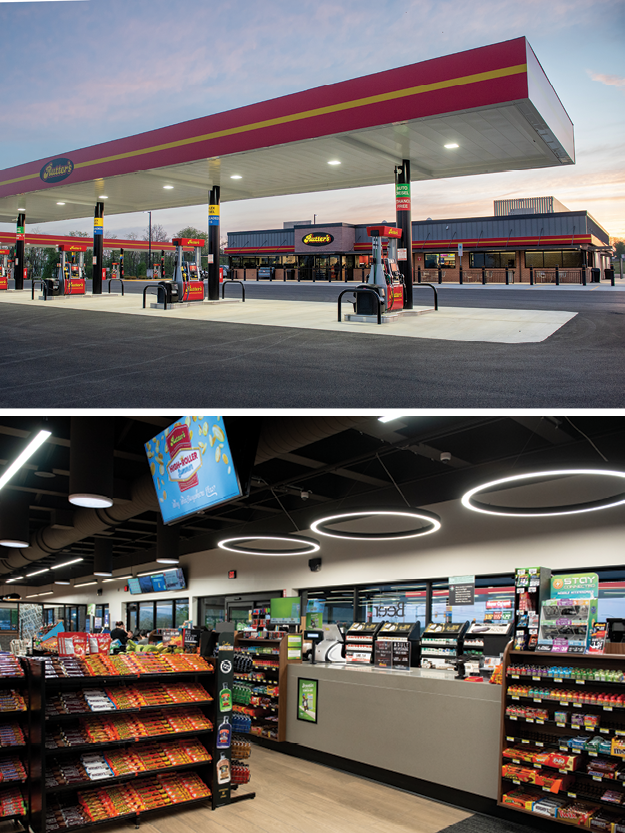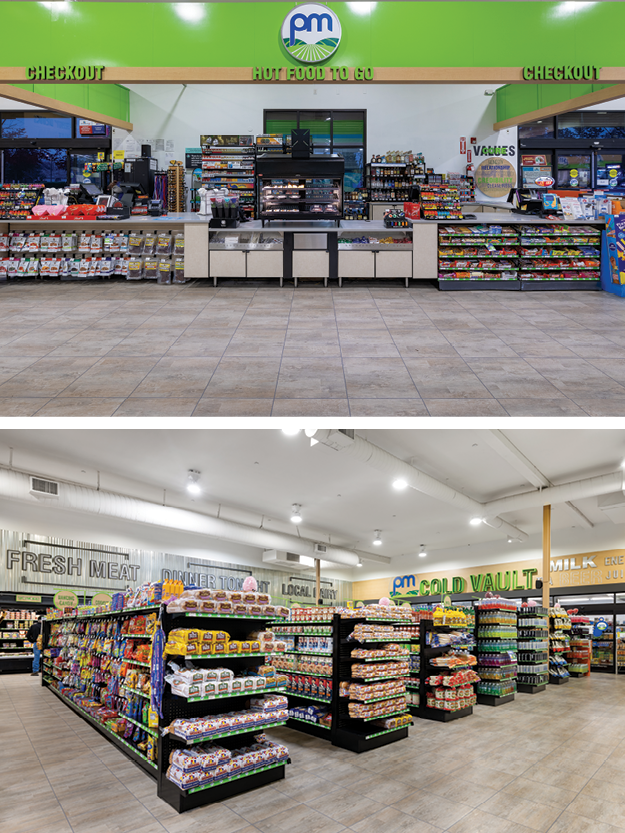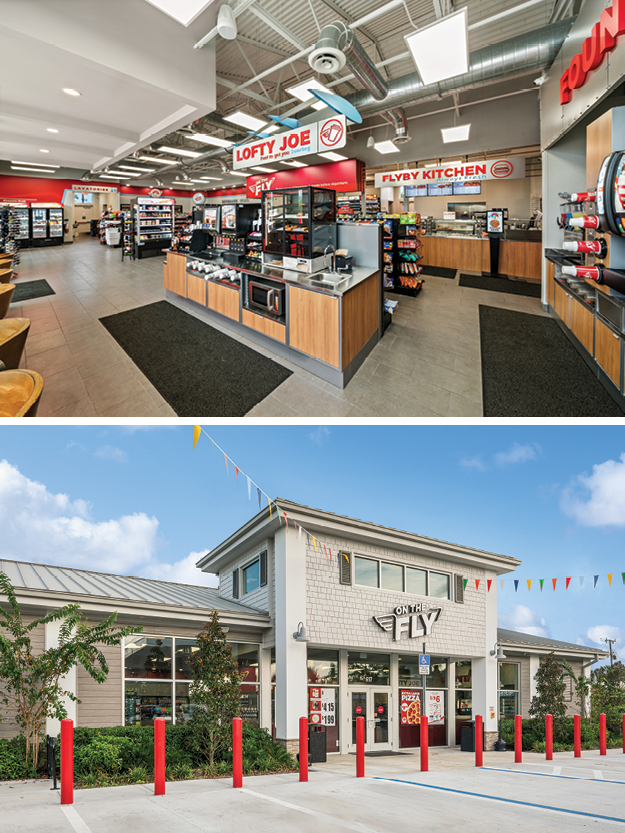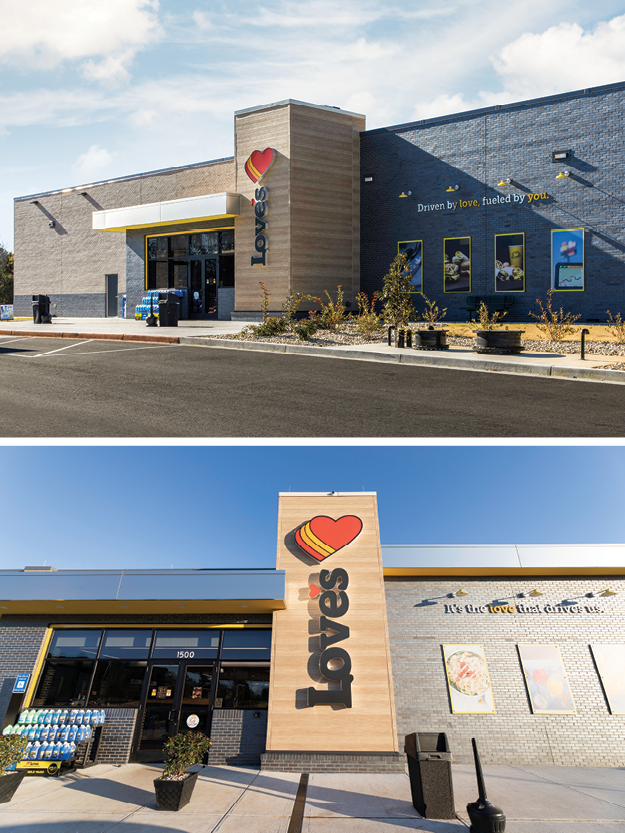What’s your business model?
Across the 152,000 c-stores in the United States, that question will determine whether new builds or remodels make more sense.
Plenty of operators are experts at taking over existing locations and either mostly keeping them the same or doing a quick remodel. Others have store personalities that require more square footage and a consistent brand experience.
The Case for New Builds
Rutter’s operates a chain of 87 convenience stores in states including Pennsylvania, Maryland and West Virginia, and opens multiple new stores a year that are at least 10,000 square feet in size.
Almost always, these new locations are built from the ground up, said Chris Hartman, vice president of fuels, advertising and development, though about once a decade the chain might go into an existing building.
For Rutter’s, “We prefer new buildings because we have a unique offering—foodservice, big coolers, large bathrooms, gaming in Pennsylvania, and we have large beer caves,” said Hartman. “It’s very hard to find existing stores that fit our footprint.”
A new build is more cost-effective and fits Rutter’s style better, Hartman pointed out, “rather than trying to put a square peg into a round hole.” If Rutter’s goes into an existing building, “It almost ends up being a new store” he said.
New builds also require ample acreage to incorporate a large store, parking, a car wash, and fueling/forecourt space.
Most Love’s Travel Stops stores are new builds “because that allows us to develop a location that meets our standards, including an open and modern store layout that includes showers and laundry,” said Randy Swain, director of construction and remodels for the Oklahoma City-based company.

For new builds, the biggest advantage, Swain said, is that Love’s can work off of “the new store playbook we have developed with our contractor partners, allowing us to design and build a facility that fits the space and meets customers’ needs.”
New builds, said Blake Holton, vice president of operations at King Retail Solutions, Eugene, Oregon, mean “You can drive the space, instead of the space driving the layout.”
They are also likely to last longer. “You’ll have more years out of that asset and more years of quality function from mechanicals to refrigeration to finishes,” Holton says. New sites can incorporate more sustainable features like energy-efficient equipment and eco-friendly materials. This is important to younger shoppers, he pointed out.
An additional expense with new builds is that some states now require that c-stores retain their own stormwater on site. “A lot of places don’t have the money to put that detention pond underground,” says Mike McMunn, permitting manager, Royston LLC, a Jasper, Georgia-based company that designs interiors, including made-to-order cabinetry and shelving for convenience stores. Existing locations may not be required to put these in unless the c-store operator is expanding the building.
Remodel Benefits
Remodeled locations can typically open their doors as a new convenience store in eight to 12 weeks, said Danny White, vice president, construction services for Royston, versus four to 12 months for a new build.
A benefit of going into an existing location is the ability to make quick changes like updating shelving and gondolas, which can make a significant difference in just a few weeks. It’s also “drastically less expensive,” Holton said. “But you have to consider your return on investment.” That return might come slower with a renovated location because it may not have the excitement of a new, ground-up build, he said.
Rutter’s considers remodeling existing stores if it finds them in a great location and if they were previous c-stores that already have good bones, layout and infrastructure.
On a few occasions Love’s has acquired existing sites. In 2023, it acquired 11 EZ Go turnpike travel plazas and converted all the store locations except one, which it will raze and rebuild in 2025.
“We switched out the logos and incorporated more of our brand colors on the walls,” said Lance Schmidt, director of facilities maintenance at Love’s.
“Where appropriate we updated the layout of the sales floor. We also upgraded key sales floor equipment that customers count on, including fountain drink machines and ice makers,” said Schmidt.

One of the biggest challenges was making the exteriors of the former EZ GO sites look and feel more like a Love’s. That included changing out the gas and diesel canopies so they were brighter, safer and representative of the Love’s brand.
There are advantages to a remodeled and rebranded locations, Swain pointed out, like having infrastructure from a restaurant and retail section. This can “make things more seamless and is less costly in the short term.” However, he adds, “the customer experience always comes first so if infrastructure is seriously outdated, we will replace it.”
Another plus, Swain said, is that existing locations already have a track record and reporting that Love’s can access in most cases.
When Love’s goes into a preexisting space, the first changes are updating the signage and branding, including the store front, interior fixtures, fueling canopies and pumps, as well as the restrooms. “We also make it a priority to add other services customers are used to, including Love’s Fresh Kitchen options and fueling at our diesel bays,” said Swain.
Going into remodel sites varies vastly from one to another. Sometimes retailers do a complete knock-down of the inside, said Holton, which gives them more potential sites to consider, including prime real estate.
In a location that needs a remodel, Holton said, c-stores are also reliant on what the previous operator wanted. It’s still a previously owned store, built to suit someone else’s retailing strategy, he pointed out, even if you strip it back to the studs and remodel it aggressively.
Renovated locations with higher ceilings help create spaces that feel larger and more inviting, and “allow for the use of clerestory windows and more natural light,” Holton said. Exterior facades benefit from taller walls by allowing for more interesting architectural elements.
“C-stores are really trying to provide a welcoming experience,” he explained. “How a shopper feels can have a big impact on what they buy.”
Infrastructure Importance
It’s essential to evaluate the infrastructure in an already existing space. The infrastructure can often be reused, but anticipate that upgrades will be required—either known upfront or discovered during the project.
Amber Wood, senior plumbing designer and project manager at Dialectic Engineering in Kansas City, Missouri, suggested inspecting the infrastructure early in the planning process, “because that can change quite a bit on the cost side of things.”
For electricity, there may not be enough amps. For plumbing, jurisdictional requirements may have changed for things like three-compartment sinks or mop sinks since the building was constructed, she explained.
Around 90% of the time, HVAC systems can be reused, she said, especially if the space was already a convenience store. Generally, if HVAC equipment is more than 10 years old, she recommends replacing it.

“Layout changes, adding kitchen equipment, what the space was previously used for, and jurisdictional requirement updates all could potentially increase the possibility of needing to revise the HVAC system,” she added.
In converted spaces, said Wood, what’s under the concrete slab or inside the walls may not be known until renovations begin. She recommended X-raying the slab before signing a contract. Also, conducting a survey of a space and knowing what services and utilities exist can help uncover potential problems. “The more we know, the better we can help offset those hiccups later in the project.”
Other infrastructure considerations include whether restrooms are being moved, as plumbing may need to be relocated or placed deeper. ADA requirements may also require additional adjustments to the restrooms, like changes to the ductwork, plumbing, ventilation and electrical.
It’s a good idea to start planning a remodel around making a building ADA-compliant, said McMunn, then work from there. ADA is especially important in the bathrooms, so wheelchairs can turn around, he pointed out.
“We’re going to have to rebuild if it’s not ADA-compliant, or even move [the bathrooms] to a different area of the store,” said White. “Any time we go into an existing space the bathrooms drive the ADA compliance.”
Grease interceptors
Convenience stores that prepare food may need to install a grease interceptor to comply with local regulations. These devices are intended to prevent fats, oils and grease from entering the sewer system. “Out West, because water is at a premium, they are recycling water at every possible turn and require grease interceptors everywhere, even if you don’t have raw food,” said Mike McMunn, permitting manager, Royston LLC. “If you have anything grease-related that you would need to wash in a three-compartment sink, you need a grease interceptor,” he explained. McMunn said that grease interceptors are typically 100 to 500 gallons and take up a lot of space underground, which can be “a huge factor,” especially in urban locations with less space. Grease interceptors cost anywhere from $5,000 to $30,000. McMunn shared that this requirement has changed a lot of the “dynamics of how sites are being identified.”
Budget and Time
The two factors that typically derail construction projects are budget and time.
It’s important to be realistic and do plenty of due diligence, suggested Hartman of Rutter’s, and to make sure there is a clear understanding among all project stakeholders on the scope of the budget and the timeline for completion.
This can help avoid pitfalls—“or they’re not as numerous, because you’re aware of 80% of them versus having them all hit you at different times, and that’s when a lot of the unexpected expenses can come in,” said Hartman.

Operators who exceed their budget will, for years, deal with a lower ROI, pointed out Tim Spiegelglass, owner of Spiegelglass Construction Company, Maryland Heights, Missouri. It’s important to put time into the budgeting step and to have a contingency budget, he added, which is about 10% of the job.
Spiegelglass first comes up with a budget, then shares it with his client, and then can adjust with some value engineering, such as using less expensive finishes.
If you’re renting the site, talk to your landlord, Spiegelglass said. Often the landlord will pay for, or partially pay for, improvements to the building like a new roof or allow the operator to pay off certain improvements over time.
When it comes to timing, Chuck Taylor, director of operations at Englewood Construction in Lemont, Illinois, commonly sees things fall apart when there’s poor coordination between the equipment schedule and the construction documents.
Therefore, he says, it’s important to “make sure equipment’s available when it’s needed, or it could derail the entire schedule by several days.”
Taylor keeps both a master schedule and a three-week schedule that includes a look ahead, pinpointing exactly what’s happening daily. As he wraps up each day, he creates a log that details what happened and compares it against the three-week schedule.
Current Trends in C-Store Design
There’s no one “right way” to design a convenience store. But there are lots of opportunities to stand out and build a brand, according to Austin Burns, president and CEO of design firm Paragon Solutions, Fort Worth, Texas. Following a slow period in terms of interest in store remodeling or new construction in the second half of 2024, Burns said he saw inquiries pick up as the second quarter approached this year.
“I think everyone … was waiting to see what the results of the election were going to be, what impact that would have on rates and the cost of capital and so on,” he said. “Conversely, there’s been a hangover following the election, too, followed by the holidays. People are just now saying, ‘Let’s get going.’” Now he sees “a lot of interest in retailers reinvesting in themselves, not just updating stores, but developing brands and brand consistency, a cohesiveness between stores,” said Burns, who took on the role of president and CEO of Paragon in June, when founder Mike Lawshe retired. “It’s a fun time in the industry right now. You’re starting to see younger leaders stepping up, trying to do some different things. It’s a great time for companies to reinvest in themselves, to explore different ways to reach clientele, to think about who you are as a brand. We always say, ‘Don’t compete, differentiate.’” Burns shares some common—and some not-so-common—elements retailers are incorporating into their stores to do just that: differentiate.
Common
Better restrooms. “The No. 1 thing is restrooms. Everybody wants to have good, clean restrooms. … People have an expectation now. If you don’t have a good restroom, you’re missing out on a lot of clientele.” Specifically, Burns said, you’re missing out on women and families. “Restrooms pay off. Restrooms are a profit center. Restrooms are worth it.”
Building up foodservice. “Consumers are looking for experiential. There’s opportunity in developing a good food program and then lighting it in the store. Maybe it’s a little more theater, with an open kitchen concept to appeal to the five senses.”
Lighting. “There’s a need for a quality, well-kept, well-lit and safe environment.”
Attention to local. “People are looking for things that relate to them from a local perspective.” In the Northeast, for example, retailers are shrinking the fountain area, committing that space to the coffee/hot drink bar, instead. It can also mean blending in architecturally. “Tying into local design requirements is a big deal. Store owners should understand that this is not a limitation. It’s an opportunity.”
Smaller stores/attention to labor. “With the growing cost of labor and construction, you’ve got to find a way to do it cheaper. … Bigger is not always better. … Clients are asking: How can we be more efficient with what we’re doing?”
Uncommon
Beer caves. “These continue to be a unique element if they’re done right.”
Delivery/curbside pickup. “It’s a bit of a Covid hangover, but clients are asking a lot of questions about that. ‘Is it right for my location?’”
Self-checkout/frictionless. “This has been scrutinized. When I speak to new clients, they’re not saying, ‘We have to have self-checkout.’ Instead, it’s, ‘What are your thoughts on self-checkout?’ My guidance is always: ‘What is your brand?’ Then we consider geography. Does it fit the location?”
Drive-thru. While still rare in the industry, “There’s a lot of interest in learning more about drive-thru.”
How do retailers decide if these elements are right for their stores?
“The question I always ask our clients is: ‘Why are we doing this?’” Burns said. From there, he urges clients to be realistic based on store size, location and budget. “Let’s answer those questions: What are your profit centers? What are we trying to heighten the experience of to get the best return on your investment?”
—Steve Holtz